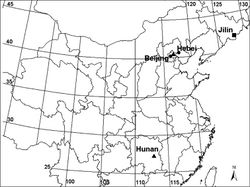Acanthoneta dokutchaevi
| Notice: | This page is derived from the original publication listed below, whose author(s) should always be credited. Further contributors may edit and improve the content of this page and, consequently, need to be credited as well (see page history). Any assessment of factual correctness requires a careful review of the original article as well as of subsequent contributions.
If you are uncertain whether your planned contribution is correct or not, we suggest that you use the associated discussion page instead of editing the page directly. This page should be cited as follows (rationale):
Citation formats to copy and paste
BibTeX: @article{Sun2014ZooKeys375, RIS/ Endnote: TY - JOUR Wikipedia/ Citizendium: <ref name="Sun2014ZooKeys375">{{Citation See also the citation download page at the journal. |
Ordo: Araneae
Familia: Linyphiidae
Genus: Acanthoneta
Name
Acanthoneta dokutchaevi Eskov & Marusik, 1993 – Wikispecies link – Pensoft Profile
- Poeciloneta (Acanthoneta) aggressa non Chamberlin & Ivie, 1943: Eskov and Marusik 1992[1]: 34–35, figs 11–13 (♂).
- Poeciloneta (Acanthoneta) dokutchaevi: Eskov and Marusik 1993[2]: 52, figs 49–51 (♂).
Material examined
1 ♂, China, Jilin Province, Mt. Changbaishan, Ski. 42°01.54'N, 128°04.25'E, alt. ca 1260 m, 31 July 1971.
Description
Male (Fig. 6A–B). Chelicera long, with strong stridulatory ridges. Chaetotaxy: Ti I–IV: 2-2-2-2; Mt I–IV: 1-0-0-1; Tm I about 0.80, Tm IV present. For other somatic characters see description by Eskov and Marusik (1993)[2].
Male palp (Fig. 6C–E). Cymbium with proximal apophysis erected. Paracymbium wide, with two pointed teeth on lateral margin. Distal suprategular apophysis modified as pit hook. Embolic division: radix long and narrow; Fickert’s gland located within radix; embolus main body trunk-like with serrated area, pointed embolus proper and well developed thumb; lamella characteristica fork-like branched, long and slender, almost parallel to radix; terminal apophysis with distal membrane and two strongly sclerotized teeth on ventral side.
Female. Unknown.
Remarks
The male of this species is similar to the type species Acanthoneta aggressa. It differs only by the shape of the paracymbium. For a detailed comparison see Eskov and Marusik (1993)[2].
Distribution
Far East Asia: Magadan Area (Eskov and Marusik 1993[2]) and China (Fig. 7) (new record).
Taxon Treatment
- Sun, N; Marusik, Y; Tu, L; 2014: Acanoides gen. n., a new spider genus from China with a note on the taxonomic status of Acanthoneta Eskov & Marusik, 1992 (Araneae, Linyphiidae, Micronetinae) ZooKeys, 375: 75-99. doi
Other References
- ↑ Eskov K, Marusik Y (1992) On the mainly Siberian spider genera Wubanoides, Parawubanoides gen. n. and Poeciloneta. Arthropoda Selecta 1: 21-38.
- ↑ 2.0 2.1 2.2 2.3 Eskov K, Marusik Y (1993) New data on the taxonomy and faunistics of North Asian linyphiid spiders (Aranei Linyphiidae). Arthropoda Selecta 2: 41-79.
Images
|
![Figure 6. Acanthoneta dokutchaevi (A–G) and Acanthoneta aggressa (H–J). A male, dorsal B male, lateral C male palp, prolateral D male palp, ventral E male palp, retrolateral F embolic division, ventral G embolic division, dorsal H epigynum, ventral I epigynum, posterior J epigynum, lateral (H–J photos provided by Don Buckle). EB epigynal basal part; EM embolic membrane; EP embolus proper; FiG Fickert’s gland; LC lamella characteristica; P paracymbium; PCA proximal cymbial apophysis; PH pit hook; R radix; SC scape; ST stretcher; TA terminal apophysis; TH thumb of embolus. [Scale bars: mm].](https://species-id.net/o/thumb.php?f=ZooKeys-375-075-g006.jpg&width=179)
